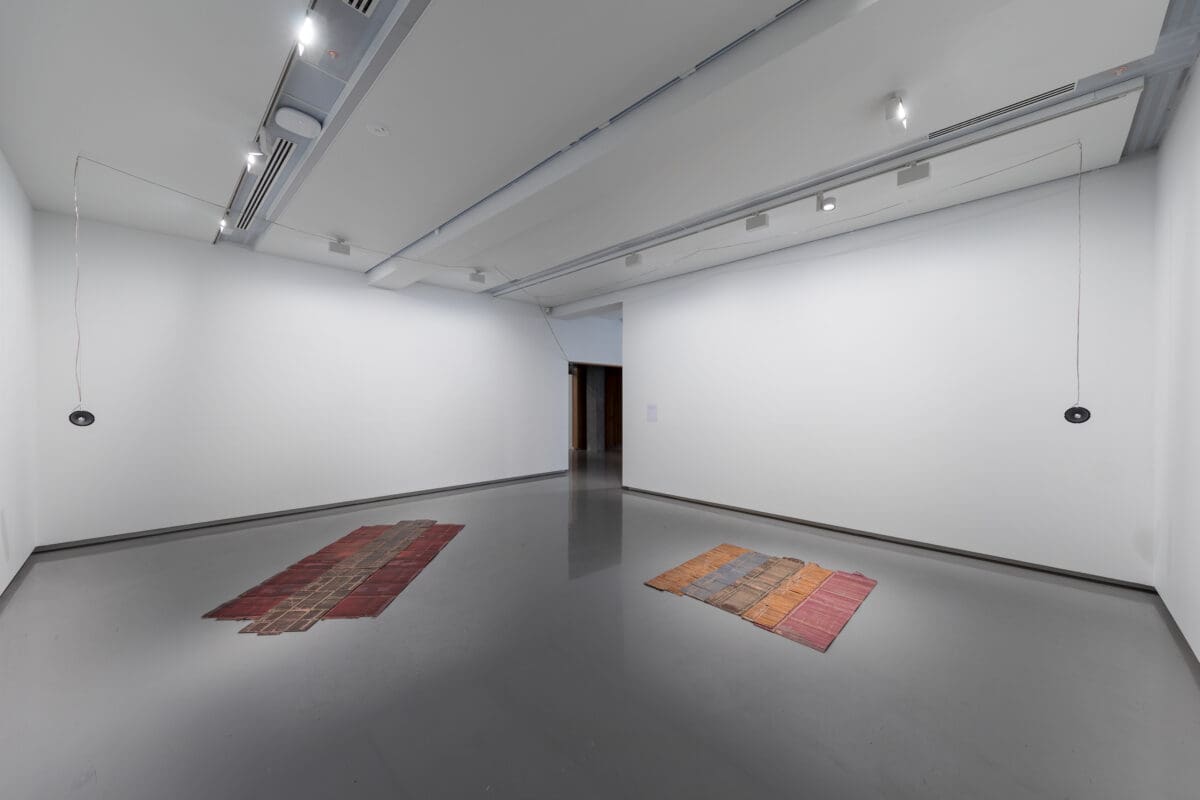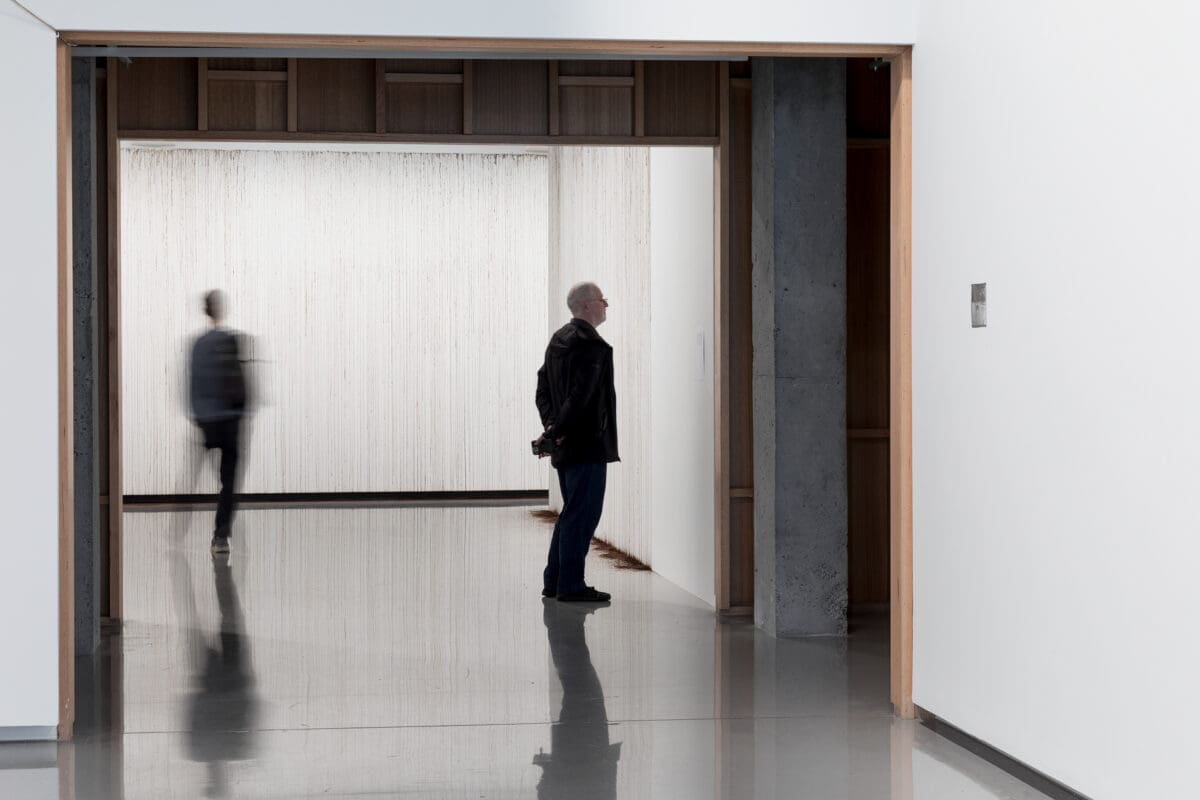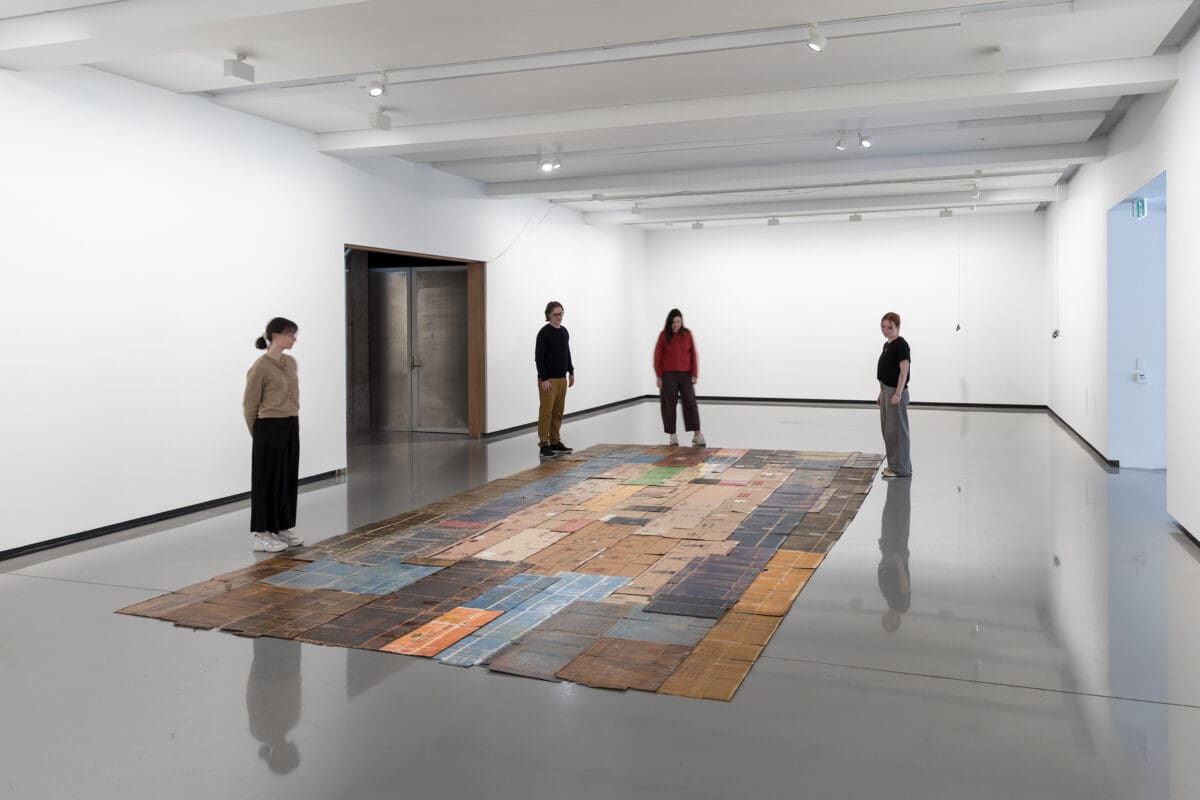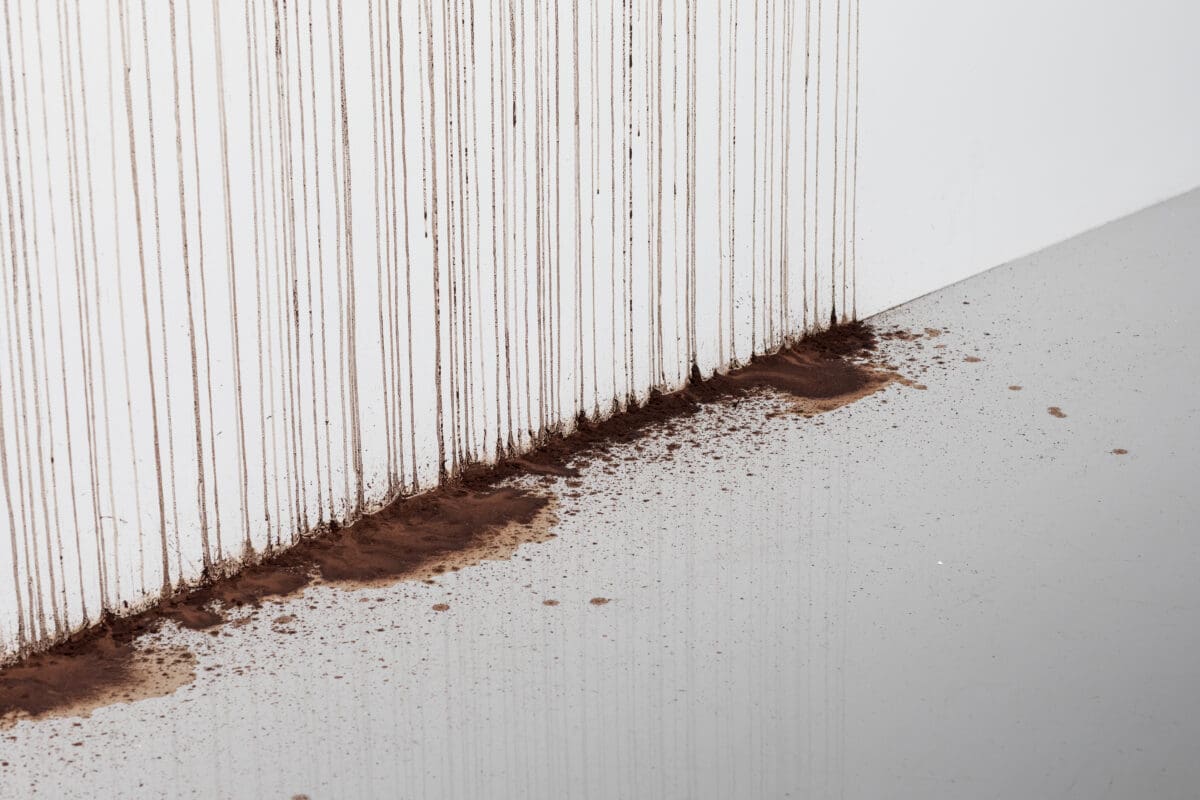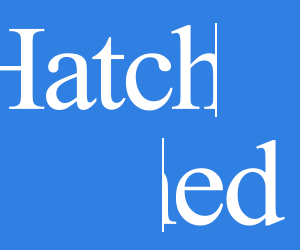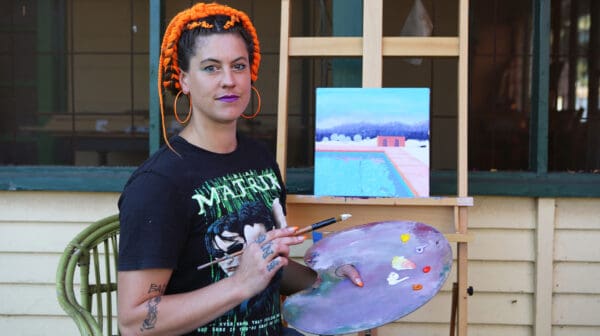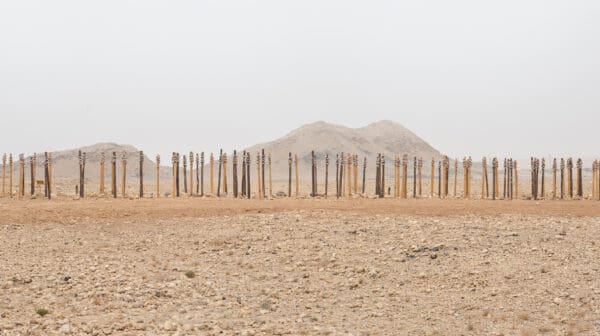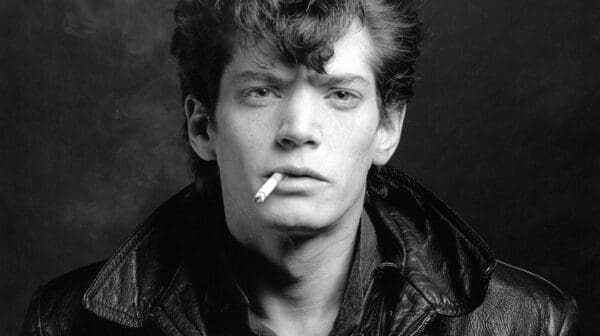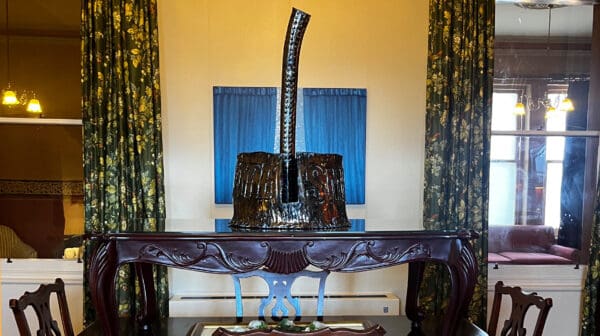After a lengthy postponement to consult with staff and students, the exhibition Flat earth at Monash University Museum of Art (MUMA), featuring works by Stolon Press, Elisa Taber, and Khaled Sabsabi, was finally green-lit. It is one of the most complex, minimal, thought-provoking exhibitions I have ever seen. It is also full of glorious, seductive colour, accompanied by a background aroma of Lebanese coffee.
My interest in seeing this exhibition was aesthetic, intellectual, and sensual. For many decades I have been exploring the gaps between installation art and literary fiction in works I call Superfictions. I see the gaps between disciplines of any kind as being more experimental and risky than sticking to the standard canon of a closed paradigm artform. So when I read the following statement from Stolon Press (comprised of artist Simryn Gill and writer Tom Melick) on MUMA’s website, I had to find out more: “Working with the question of how an exhibition might be a book, Flat earth presents a diagrammatic flat plan of a proposal in space.” Others have written about how Stolon Press operates “in the fertile space between image and text.” I increasingly see it in the—by now, clichéd—Leonard Cohen lyric about “the crack where the light gets in.” What others perceive as a flaw can be a route to enlightenment.
I spoke by phone to Simryn in her Marrickville, Sydney studio, from my studio in Euroa, Northern Victoria. And it’s important to note, given Stolon Press’s philosophy and methodology that the word Stolon is variously defined as a horizontal connection (without hierarchy), also called a runner between parts of an organism, giving rise to branches and roots.

Peter Hill: Is the exhibition we now see at MUMA the same as the one that was postponed before Sabsabi’s Venice Biennale cancellation?
Simryn Gill: The simple answer is that no it isn’t. The way Stolon Press works is in an active mode, dealing with issues of exchange, cohabitation, neighbourliness, and conversation. Even although we were a couple of months out when the cancellation happened, we were still in that active mode, and the final show hadn’t ‘landed’ as a concept. Because of what happened, we actively opened up the conversation again, Tom Melick and I, with the other two artists: Elisa Taber, an Argentinian anthropologist currently studying in Montreal, and Khaled Sabsabi. Tom and I work collaboratively as Stolon Press, so in effect there are three artists in the show, and the whole installation has been curated by Stolon Press. We decided to produce an exhibition that was activated by the events we had experienced. The initial invitation to work there had come a very long time ago from Charlotte Day [previously director of MUMA, now director of Art Museums at the University of Melbourne]. Then the project was inherited by Rebecca Coates [director, MUMA], and we are very grateful to her and Stephanie Berlangieri [curator, research at MUMA] and all the current staff at MUMA. Initially, I was invited to make a project. I was keen to do something that would be accompanied by a book. Then I expanded it to Stolon Press and invited Tom Melick in. We then looked at it and decided to make the book and the show into one thing. We would then be working in our favourite place in the gap between text and art, similar to your own practice, Pete. And maybe even dematerialising the book into a space or format. How would that look and how would that work? It was a very complex, intellectual undertaking, but it’s not an ‘issues-based’ project.
PH: I’d like to ask you about working in those gaps between art and literature, and how you synthesise them?
SG: Stolon Press really came about because Tom invited me to write a piece for [SLUG] (an online pamphlet series). A little later we met for the first time, and through our conversations we realised we had similar questions and curiosities about that: When does writing become art, when does art become writing? It’s important to say that we were not interested in the traditional artist book format, where the book is convoluted into an artwork. We were interested in serious writing, especially the kind that tends to not be picked up by other publishers. There are less and less places to put things out. Also, a lot of the smaller literary magazines were finding support harder and harder. So, we decided to try it, as one does, working initially in a small way with our own texts and a photocopier. We wanted to find out if our curiosity had legs, and if so, how deeply we could dive with that. And we needed to do it in a way that was manageable in terms of cost but still make it using paper because of the way we physically receive ideas through paper rather than online. And that’s what led us on to wondering if images could become writing and vice versa. How do they share the space? How can you tame writing? Because when you put writing next to an image it kidnaps the image. These were nice kind of backyard questions that we started to play with. And then we eventually ended up working together on the kitchen table.
PH: Elisa Taber presents a beautifully conceived techno-minimalist piece. She has suspended speakers in every gallery. They will remain silent throughout the run of the show except for one day when she will transmit a text from her current base in Canada.
SG: Yes, at 7am in Montreal and 9pm in Melbourne on the 27th June. Her first language is Spanish. She wrote a book called Archipelagos in a Landlocked Country. She wrote it in English and she’s now translating it back into Spanish. At MUMA, she’ll be reading selected parts of that book in English and in Spanish. She had originally planned to show a series of small films she’d made on her iPhone which are also a form of text, but with the exhibition’s delay and her own busy timetable she could no longer visit Melbourne to install the works. And so the speakers and the readings grew out of that. It’s a very poetic and minimal work. At the moment we know her readings will be coming from those texts, but we don’t yet know which passages. And you have to be in the gallery to hear it, it won’t be streamed.
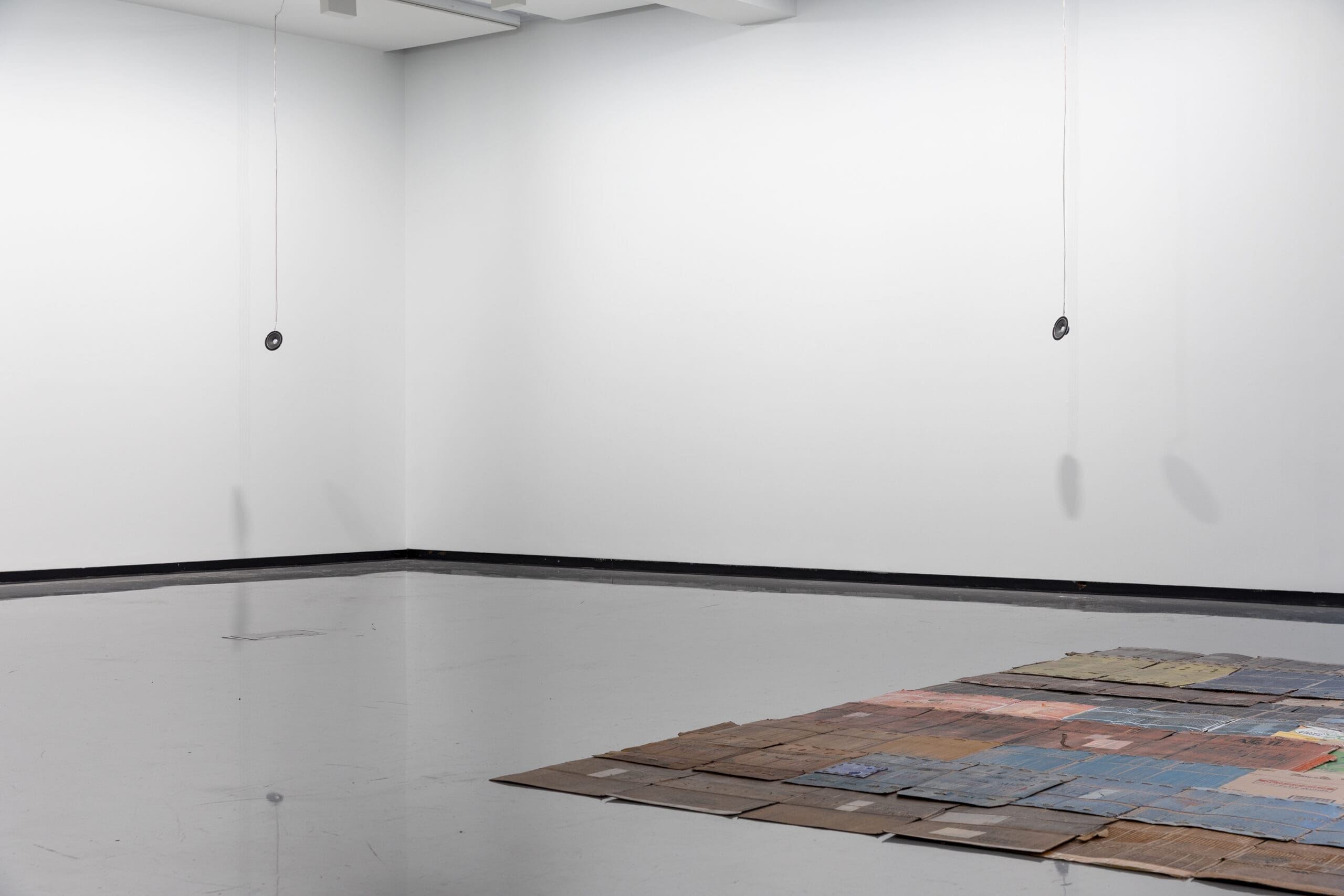
PH: Tell me about the floor pieces in the gallery.
SG: Tom and I started picking up boxes on our street in Marrickville, where our studio is. And we started looking at all the writing and the labelling on the boxes – where the goods come from, who imports them, how long they are viable for. And obviously some of them had to do with the strange trade wars we’re all living under. The truck, and you probably saw the photograph in the gallery, is a mode of movement for these fruits and nuts, but it – the truck – also straddles an incredible period of time with its Swedish brand and its hardwood rain forest body. It becomes like a huge oxen cart. So, it’s in two main parts and we also got to thinking about that ship that got itself tangled up in the Suez Canal and blocked all the movement of freight. There was a great journalistic photo of a donkey cart plodding alongside the canal and the container ship jamming the Suez. Our conversation continued, and Tom said, “You’ve been working with colour recently, it might be good to do something with the fruit boxes and colour.” So, with our printmaking collaborators in Sydney and Melbourne we started working directly with the presses and taking prints from the boxes. When you do that, you’re left with these pieces of cardboard with beautiful ink on them. These boxes were piling up in the studio and when we had to figure out how to reconfigure this show with Elisa not being able to come, it seemed right for Stolon Press that we look at the residue of what we had, rather than the beautiful prints we’d been making.
At that point we thought about the work that we’d started to make with Khaled and his earlier coffee-based installations. It made so much sense to make these into floor rugs. Maybe they were connected, maybe not. But we started to look for more boxes to add to the already inked ones we had. Importantly, in a typical Stolon Press way, it brought together all these collaborators who we have a relationship with. Some friends from Sydney even flew down for the show, and they ended up working with us on these final pieces.
PH: And did Khaled Sabsabi manage to come down for the show?
SG: No, he wasn’t in the country. This is the third version of his coffee installation, the first was in 1998, the second time was in 2020, and this is the most ambitious to date. Tom and I went to visit him in Western Sydney and he trained us. He was very insistent that Tom’s hand should do the installing and he worked very closely with two students and an assistant of mine who came out to do it. And again, the work went up in under three days. Khaled gave us the precise formula for the liquid coffee and we FaceTimed him while we were doing it. This is a testament to the incredible collaboration and trust around this project and with others.
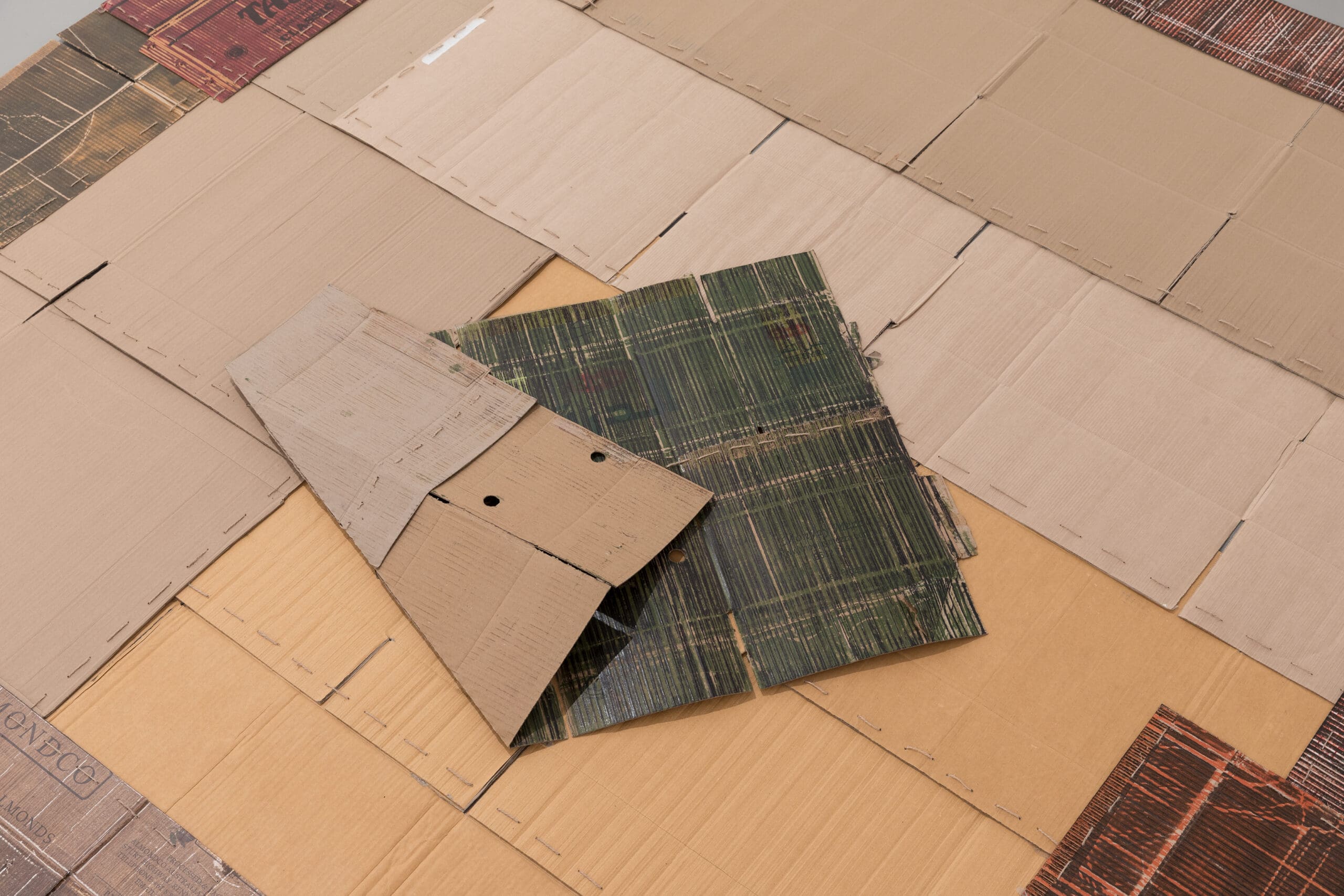
PH: And did part of one of the floor pieces point towards Mecca?
SG: We said to Khaled before he left, “Would you be agreeable if we put a prayer rug in one of the spaces?” And he sent Tom the correct computer coordinates but also said when a prayer rug is not in use one corner of it should be folded back. And a prayer rug is never directly on the ground…another one should be under it. So, we made a larger rug to receive the prayer rug. This also fits with Stolon Press’s idea that we don’t have discrete spaces, but they should all overlap. And the aroma of Khaled’s coffee permeates the whole space, just as Elisa’s voice will go through all the spaces simultaneously. Then if you look at the flat boxes you see where everything’s come from. It’s the start of a whole different story: Syrian soap, Iranian apricots, Palestinian dates, Thai noodles, Australian eggs and American walnuts. It’s great!
Stolon Press: Flat earth
Monash University Museum of Art
Until 12 July





